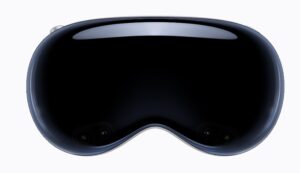Apple Vision Pro is a groundbreaking spatial computing device that seamlessly integrates digital content into the physical world while keeping users connected and engaged. Vision Pro extends the canvas for apps far beyond the limits of conventional displays, introducing a fully three-dimensional user interface that responds to the most natural and intuitive inputs—your eyes, hands, and voice. Powered by visionOS, the world’s pioneering spatial operating system, Vision Pro enables users to interact with digital content in a manner that mimics physical presence in their surroundings. This innovative design showcases an ultra-high-resolution display system that houses an impressive 23 million pixels across two screens. Additionally, it incorporates custom Apple silicon within a unique dual-chip configuration to ensure every interaction feels like it’s unfolding right before your eyes in real-time.
Apple Vision Pro offers a glimpse into the future of spatial computing, promising an immersive blend of the digital and physical realms. With its groundbreaking technology, it opens up exciting possibilities while also presenting certain challenges. In this article, we’ll explore the advantages and disadvantages of Apple Vision Pro, shedding light on its potential to revolutionize our interaction with technology.
Advantages of Apple Vision Pro:
- Enhanced Augmented Reality Immersion: Vision Pro excels in providing an enriched augmented reality experience. The headset seamlessly merges virtual elements into the real world through advanced optics and sensors, enabling users to interact naturally with digital content. This heightened immersion opens up exciting possibilities in fields such as gaming, education, design, and more.
- Exceptional Display Quality: Vision Pro boasts a top-tier display renowned for its clarity and vibrancy. Apple’s meticulous attention to detail shines through in the headset’s display technology, offering outstanding resolution and color precision. This elevates the overall augmented reality encounter, ensuring stunning visuals for users.
- Robust Hardware Performance: To ensure a seamless augmented reality experience, Vision Pro is equipped with potent hardware. Apple’s custom-designed processors and graphics capabilities guarantee smooth and efficient handling of complex AR applications. Users can enjoy high-fidelity AR content without encountering any lag or performance issues.
- Seamless Integration with Apple Ecosystem: As a product from Apple, Vision Pro seamlessly integrates with the existing Apple ecosystem. Users can harness the power of Siri, Apple’s virtual assistant, to control the headset through voice commands. Moreover, its integration with other Apple devices such as iPhones and Macs facilitates effortless content sharing and enhanced functionality.
Disadvantages of Apple Vision Pro
- Premium Price Tag: One significant drawback of Vision Pro is its expected high cost. Cutting-edge technology often comes with a premium price, and this AR headset is no exception. The steep pricing might limit accessibility to a broader consumer base, potentially relegating it to a niche product.
- Limited Field of View: Initial reports suggest that Vision Pro has a relatively narrow field of view, restricting peripheral vision for users. This limitation could diminish the immersive experience and pose challenges for applications demanding a broader field of view, such as gaming and navigation.
- Potential Health and Safety Considerations: AR headsets like Vision Pro are worn on the head for extended periods, raising concerns regarding potential health and safety issues. Extended usage may lead to discomfort, eye strain, and headaches. Additionally, issues related to motion sickness and spatial awareness may arise, especially for individuals prone to such conditions.
- Dependency on Third-Party App Support: The success of Vision Pro heavily relies on the availability of a robust ecosystem of AR applications. While Apple’s reputation and developer community are strong, the initial availability of applications may be limited. Without a wide range of compelling apps, the device’s potential and value could be diminished.
Apple Vision Pro Considerations
- The ‘Fashion Factor’: Arguably one of the most significant challenges to overcome is the device’s appearance. Unlike traditional eyeglasses or helmets, which people may wear for practical reasons, Apple recognized the importance of making Vision Pro visually appealing. Although it fares better than many competitors, the Vision Pro still has a somewhat unconventional appearance, which might not align with some users’ fashion preferences.
- Productivity Considerations: For productivity-focused tasks, a head-mounted display or computer must accommodate input methods. Vision Pro primarily offers three user interfaces: eye tracking, hand tracking, and voice control. While eye tracking is relatively mature and should function well with the device, concerns arise with hand tracking and voice input. Virtual keyboards, which Apple envisions for data entry, lack the tactile feedback of physical keyboards, potentially making hand placement challenging. Additionally, Apple’s voice assistant, Siri, may not match up to the advanced natural language processing capabilities found in technologies like ChatGPT. Consequently, many users might opt for the inclusion of a physical keyboard and mouse to enhance their productivity when using Vision Pro.
Apple Vision Pro represents a significant leap in spatial computing, offering a host of advantages such as an immersive AR experience, high-quality display, powerful hardware, and seamless integration into the Apple ecosystem. However, it is not without its drawbacks, including a potentially high cost, limited field of view, concerns about health and safety, and a dependency on third-party app support. As this groundbreaking technology continues to evolve, users will need to weigh these pros and cons carefully to determine whether Apple Vision Pro aligns with their needs and preferences in the ever-expanding world of augmented reality.












